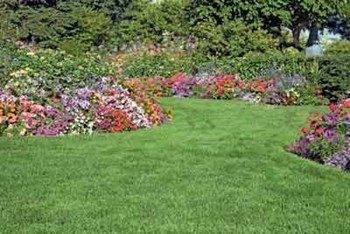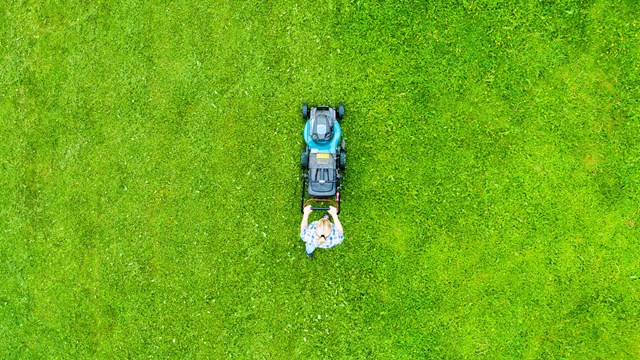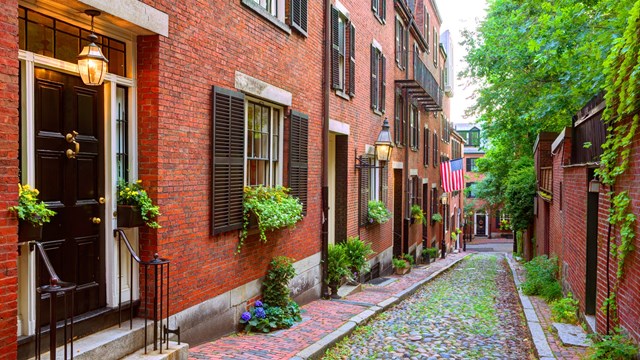
Few capital improvements bolster property values as effectively as landscaping upgrades. “It’s astonishing what redoing the landscape will do to the sales and turnaround time at a condominium,” reports landscape designer Thomas Wilhelm, APLD, of Wilhelm Landscape Design in Boston. And installing plantings better suited to your property’s ecosystem, including new hybrids specially developed to require less upkeep, can pay off handsomely in reduced monthly maintenance costs for years to come.
Hit the Books
If the board is considering a landscape renovation, a look at accounts payable over the past few years will help the association assess the cost benefits of such a project and perhaps help persuade members and owners who are on the fence.
“Go through your bills and determine where you’re spending your money,” advises Arlington, Massachusetts-based landscape designer Laura Kuhn. “Look for the landscaping contracts you are constantly revisiting. The biggest flag would be if your landscape services havebeen exceeding their budget because there are continuing problems.”
The next step, advises Wilhelm, is to “pay a landscape designer for a few hours of their time to walk the project with you. Do an assessment of existingplant materials to determine which have been properly located within the complex and which absolutely need to be replaced.”
Give particular attention to the major sidewalks that connect buildings, he says, and the entryway – the first area people see – including surrounding plantings and the signage. “One of the first things some condos ask me to do is to redesign the sign so it isn’t just a four-by-four-foot poster sitting in a little bit of planting. We might doa low wall with a raised planter bed, so when the signage gets reinstalled with granite it has a really nice look.”
Common Trouble Spots
Condominiums born during the building boom of the 1980s often find themselves today with outsized lawns – where overgrown trees have been ripped out and replaced by grass – with a few trees scattered among the buildings. And to make matters worse, as the trees have matured, they’ve createda lot more shade, depriving the remaining plants of sufficient light.
“Plants that were in full sun have become these thin, ratty-looking things,” observes Wilhelm, who advises ripping them out and replacing them with more suitable plants. The lawns themselves, he adds, “are as a rule full-sun plants. So lawns start to get thinnedout, which means you bring in large beds of shade-tolerant groundcover.”
Also back in the 1980s, developers planted a lot of imported Norway maples – attractive, fast-growing trees which were rightly thought to be extremely tough and durable. Too tough, in fact, as they are now considered “exotic invasives,” capable of breaking up walkways as their roots spread.
The same goes with some plant species. Wilhelm recalls a condo complex covered with pachysandra, or Japanese spurge. “Over the years, it had become so choked, you’ve got guys sitting out on buckets pulling weeds out of hundreds and hundreds of square feet of this ground cover.”
Another affliction common to an aging landscape is the erratic growth of “privacy hedges,” plantings originally positioned to screen units from their neighbors – natural fences, if you will – which have outgrown their purpose, leaving some owners exposedto public view.
Kuhn uncovered such a problem consulting for South Meadow Ridge, a condominium with several two-storybuildings in Concord, Massachusetts. “The company that did the original design put in a simple row of white pines to screen one building from the next,” recalls Kuhn. “Everyone was happy with it until they grew to be too large and started losing their lower branches, so you had privacy on the second floor but no longer on the first floor.”
The solution: “We did little hedges of six or seven mixed species in variousareas,” she says, customizing the mix according to their location and sunlight exposure. “We came up with a list of native evergreen and deciduous species that require less maintenance and we positioned them so they would provide optimal screening.”
Drain, Baby, Drain
A well-functioning irrigation system is essential to maintaining a healthy landscape, according to landscape architect Christopher Faria, owner of Fieldstone Gardens in Little Compton, Rhode Island. “I had a big job this spring where the owners were wondering why the trees were dying.” He discovered that they sat in standing water whenever it rained due to improper drainage. The good news, he says, is that most plants will recover once the irrigation problem is resolved.
For walkways, patios, driveways that need resurfacing to improve irrigation, “a lot of people now are going with interlocking concrete blocks which can be stamped, colored or textured to look like brick or bluestone,” says Faria. “They are permeable and the way they lock together allows for drainage.”
New Trends in Landscaping
Condominiums revitalizing their landscape today benefit from a slew of improvements in the field.
For resurfacing, along with the interlocking concrete blocks mentioned above, tumbled concrete pavers are popular now. A great variety of soft-edgestones are available in rectangular or square shapes. The pavers provide a pleasant aged, “distressed” look and can easily be arranged in interesting patterns.
Plants have come a long way in the last few decades. New hybrids require less maintenance and better resist insects and disease. These include new varieties of crab apple, Hawthorne, dogwood and elm trees, as well as beautiful shrub roses that don’t require spraying, need only minimal pruning and bloom from June until a hard frost.
The newly-developed, hardy Knockout Rose®, said to be the most disease-resistant on the market, grows fast without spraying and blooms on bushes up to nine months a year with brilliant red, pink, yellow or white petals.
Landscape designers use native plants more than ever today, to support a balanced, sustainable ecosystem and produce a self-perpetuating landscape that requires less maintenance, fertilization, pesticide and water. New England has hundreds of perennials, ferns and ornamental grasses to choose from. “We are fortunate in this latitude,” notes Kuhn, “to be at the southernmost point for a lot of northern speciesand northernmost point for a lot of southern species.”
Four-Season Landscaping
“There is a new appreciation for landscaping that speaks to you through the seasons,” says Kuhn. Native plants are at the heart of the “four-season” landscape. In addition to providing an ever-changing display all year round, mixing together native trees and shrubs that have varied bloom times producesa healthier, self-sustaining landscape.
Designing a four-season landscape, advises Faria, “you try to pick a tree, even if it is deciduous, that will have beautiful spring flowers and fall colors and beautiful bark characteristics in thewintertime.” The exfoliating bark of the heat-tolerant river birch tree, for example, is as attractive in winter as is its brilliant yellow foliage in the fall.
The four-season landscape might include the paperbark maple tree, which develops color late in the fall and displays leaves that persist into winter; needled and broadleaf evergreen trees which stay green all year round; and a host of native shrubs that produce colorful berries in winter and early spring. New England is home to many hardy ornamental grasses – very popular in landscapes today – in both cool season and warm season varieties, which, when combined, lend interest to the landscape all year round.
Planting a large landscape, says Faria, “you try to group large masses, unless it’s a specimen tree,” a uniquely brilliantplanting that can stand on its own. “If you’re using perennials, you don’t use one of this and three of that; you might use 15 or 20 in a swath.
“Especially with perennials or grasses, you want to use large amounts to make more of an impact,” adds Faria. “You don’t want to be putting in one-gallonplants, which would get lost.” Plus, to soften the corners of large buildings, “you might put a larger shrub or tree off the corner of the project that will bring the building into scale with the surroundings.”
Landscaping on a Budget
A condominium needn’t wait for flush times to begin enlivening the landscape. There are ways to make impressive improvements for a modestinvestment.
The association can break a landscaping project into phases. “Boards need to look at the most critical areas that need to be addressed and where they can get the best bang for the buck,” advises Wilhelm. Replacing shrubbery that blocks windows and encroaches on walkways is a good place to start, he says, “and shrubbery as a rule is the least expensive thing of all.” The larger, more costly jobs can be budgeted out over time. If 90 overgrown trees need to be replaced, you might commit to, say, planting 30 new ones over three years.
“Another way to save money,” says Faria, is to “start with smaller plants – if you have the patience and you are in it for the long term. If you were to buy a four-inch caliper tree wholesale you might be looking at $300 or $400,whereas I can buy a one or two-inch caliper for maybe $100 – and in two years with proper care that tree could easily be the same size as that four-inch caliper tree.”
For an economical, yet elegant decorative feature in a contemporary garden, Faria recommends using boulders as sculpture, instead of expensive statues or lanterns.
One of the least costly enhancementscondos can make to their outdoor space, recommends Faria, is to sink low voltage lighting right below the mulch. Low voltage is not subject to the expensive safety precautions that 110V lighting requires and, aimed up at a tree or the side of a building, provides a dramatic effect at low cost.
Whether budgeted at $5,000 or $50,000, “landscape projects make a real difference,” says Wilhelm. “Peopleare thrilled with renovation projects. I can’t tell you how many times clients tell me, ‘I had those big old ugly trees blocking my windows for the last 10 years. This looks so great!’”
Steven Cutler is a freelance writer from New York City.






Leave a Comment